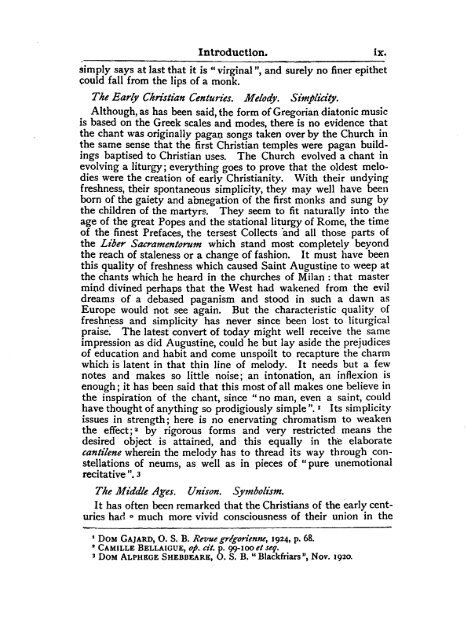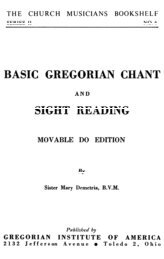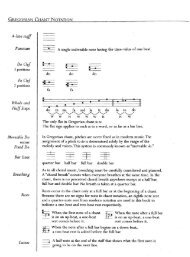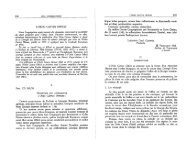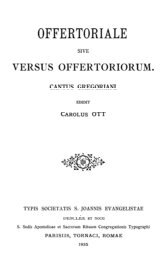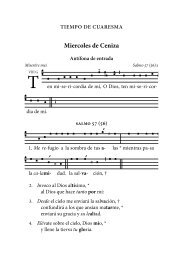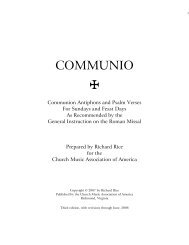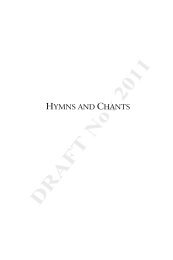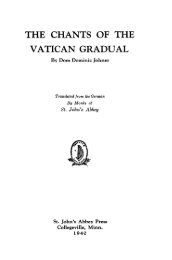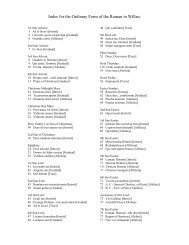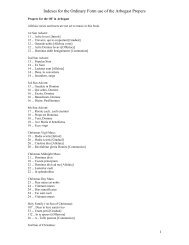Textbook of Gregorian Chant (1930) - MusicaSacra
Textbook of Gregorian Chant (1930) - MusicaSacra
Textbook of Gregorian Chant (1930) - MusicaSacra
Create successful ePaper yourself
Turn your PDF publications into a flip-book with our unique Google optimized e-Paper software.
Introduction. ix.<br />
simply says at last that it is " virginal", and surely no finer epithet<br />
could fall from the lips <strong>of</strong> a monk.<br />
The Early Christian Centuries. Melody. Simplicity.<br />
Although, as has been said, the form <strong>of</strong> <strong>Gregorian</strong> diatonic music<br />
is based on the Greek scales and modes, there is no evidence that<br />
the chant was originally pagaa songs taken over by the Church in<br />
the same sense that the first Christian temples were pagan buildings<br />
baptised to Christian uses. The Church evolved a chant in<br />
evolving a liturgy; everything goes to prove that the oldest melodies<br />
were the creation <strong>of</strong> early Christianity. With their undying<br />
freshness, their spontaneous simplicity, they may well have been<br />
born <strong>of</strong> the gaiety and abnegation <strong>of</strong> the first monks and sung by<br />
the children <strong>of</strong> the martyrs. They seem to fit naturally into the<br />
age <strong>of</strong> the great Popes and the stational liturgy <strong>of</strong> Rome, the time<br />
<strong>of</strong> the finest Prefaces, the tersest Collects "and all those parts <strong>of</strong><br />
the Liber Sacramentorum which stand most completely beyond<br />
the reach <strong>of</strong> staleness or a change <strong>of</strong> fashion. It must have been<br />
this quality <strong>of</strong> freshness which caused Saint Augustine to weep at<br />
the chants which he heard in the churches <strong>of</strong> Milan : that master<br />
mind divined perhaps that the West had wakened from the evil<br />
dreams <strong>of</strong> a debased paganism and stood in such a dawn as<br />
Europe would not see again. But the characteristic quality <strong>of</strong><br />
freshness and simplicity has never since been lost to liturgical<br />
praise. The latest convert <strong>of</strong> today might well receive the same<br />
impression as did Augustine, could he but lay aside the prejudices<br />
<strong>of</strong> education and habit and come unspoilt to recapture the charm<br />
which is latent in that thin line <strong>of</strong> melody. It needs but a few<br />
notes and makes so little noise; an intonation, an inflexion is<br />
enough; it has been said that this most <strong>of</strong> all makes one believe in<br />
the inspiration <strong>of</strong> the chant, since " no man, even a saint, could<br />
have thought <strong>of</strong> anything so prodigiously simple ". x Its simplicity<br />
issues in strength; here is no enervating chromatism to weaken<br />
the effect; 2 by rigorous forms and very restricted means the<br />
desired object is attained, and this equally in the elaborate<br />
cantilene wherein the melody has to thread its way through constellations<br />
<strong>of</strong> neums, as well as in pieces <strong>of</strong> "pure unemotional<br />
recitative ". 3<br />
The Middle Ages. Unison. Symbolism.<br />
It has <strong>of</strong>ten been remarked that the Christians <strong>of</strong> the early centuries<br />
had * much more vivid consciousness <strong>of</strong> their union in the<br />
1 DOM GAJARD, O. S. B. Revue grigorienne, 1924, p. 68.<br />
9 CAMILLE BELLAIGUE, op. at. p. 99-100 et seq.<br />
3 DOM ALPHEGE SHEBBEARE, O. S. B. "Blackfriars", Nov. 1920.


